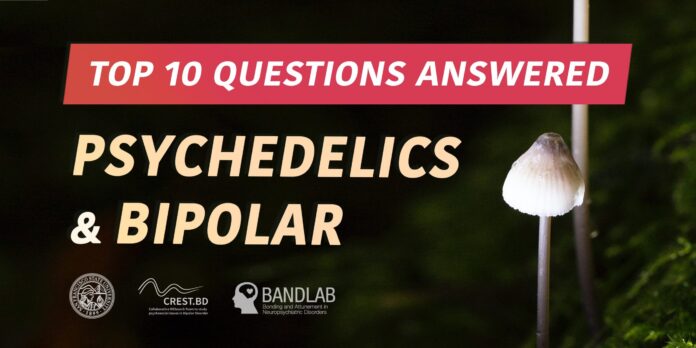Most psychedelic mushrooms are of the genus Psilocybe. Several different mushrooms fall under this genus. Four varieties of psychedelic mushrooms are well known.
- Psilocybe baeocysti grows on rotting logs and mulch, but is also found in fields. This mushroom has a dark brown cap and a brown or yellow stem.
- Psilocybe cubensis is a common choice for psychedelic mushrooms. The cap is usually reddish-brown, and the stem is yellow or white. It is often found in humid climates and growing from the dung of grazing animals.
- Psilocybe semilanceata grows in fields with grazing animals, but it does not grow on the dung. It is small, yellow or brown, and has a pointed cap.
- Psilocybe azurescens is one of the most potent psilocybin mushrooms. It grows on decaying wood and in coastal dune grasses. It has a brownish cap and bruises dark blue.
Psilocybin and Psilocin
Psilocybe mushrooms contain psilocybin, and this compound is what causes psychedelic effects. Psilocybin is produced by more than 200 different species of fungi. When the body absorbs psilocybin, it is converted into psilocin.
As the body converts psilocybin into psilocin, it affects the body and the mind. Psilocybin interacts with serotonin receptors in the brain. This, in turn, causes a reaction of mood, cognition, and perception.
Effects of Psychedelic Mushrooms
The full effect of psychedelic mushrooms varies from person to person and may include any of the following:
- Spiritual connection and awakening
- A sense of peace
- Visual distortions
- Euphoria
- Lack of coordination
- Confusion and paranoia
Mushrooms are one of the safest substances, not just among psychedelics, but among drugs in general. Mushrooms sometimes give participants a more peaceful trip in comparison to other psychedelics. However, a challenging experience or “bad trip” is always possible. Challenging experiences can be scary and result in paranoia, confusion, and anxiety. This is more likely to occur when psychedelic mushrooms are used without proper safety measures and preparation. Check out PEx’s general safety guide to psychedelics, as well as our guide to your first psilocybin experience.
There is a wealth of recent research showing different potential for psychedelic mushrooms. Jeremy Daniel and Margaret Haberman, researchers from John Hopkins University, completed research suggesting mushrooms be reclassified because they discovered psilocybin is useful for treat cancer-related distress, anxiety, severe depression, and substance abuse, including nicotine. Read more here about the benefits of psilocybin mushrooms.
Analogs/Research Chemicals
Analogs, or research chemicals (RCs), are drugs that are similar to that of controlled substances. Often, analogs are referred to as designer drugs. These synthetic drugs are challenging to regulate because they are modified enough to be different from the controlled substance.
Some compounds resemble psilocybin, and these compounds are thought to be metabolized the same as the psychedelic compounds of mushrooms. As the analog is metabolized, the effect is like psilocybin mushrooms.
4-AcO-DMT
4-AcO-DMT is structurally similar to psilocybin and psilocin, and its effects are reported to be very much like that of psychedelic mushrooms, although the high is reported to last longer. 4-AcO-DMT, an analog to psilocin, is metabolized in the body the same way as psilocin. The analog is considered a prodrug, an inactive compound that, when metabolized by the body, produces a drug.
4-HO-MiPT
Created by Alexander Shulgin, 4-HO-MiPT is a psychedelic RC in the tryptamine family, as discussed by Bill Sanders et al. in their research. This analog has an onset time of up to 45 minutes, and the duration is four to six hours. However, the duration depends on many factors, including the size of the dose and the unique factors of the individual user.
To Conclude
The experience of psychedelic mushrooms is caused by the chemical compound called psilocybin. When this compound is absorbed by the body, it changes into psilocin, which impacts the part of the brain that handles perception, mood, and cognition.
Users report feeling euphoric and peaceful. They also describe feeling a deep spiritual connection to the world. In the context of a difficult or challenging experience, some individuals report feelings of panic and confusion, as well as visual distortions.
Research tells us there are medically useful reasons to continue to invest in the study of psychedelic mushrooms. Also, some of the chemicals used in research are metabolized by the body in such a way that they mimic the effects of psychedelic mushrooms. Even though we know a fair amount about psychedelic mushrooms, there is still much more to learn!


